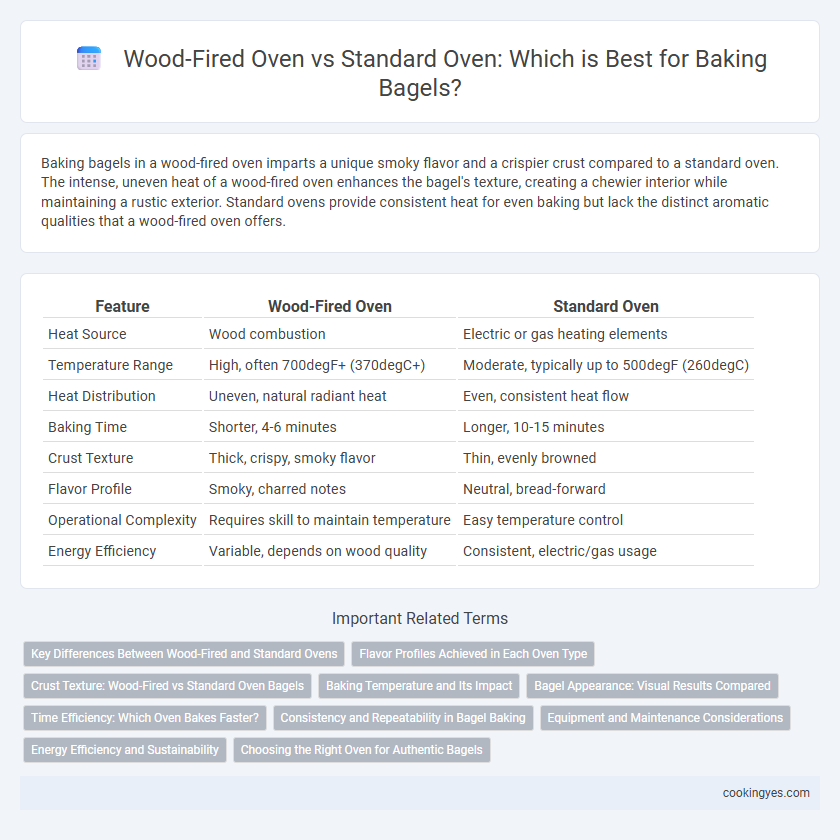Baking bagels in a wood-fired oven imparts a unique smoky flavor and a crispier crust compared to a standard oven. The intense, uneven heat of a wood-fired oven enhances the bagel's texture, creating a chewier interior while maintaining a rustic exterior. Standard ovens provide consistent heat for even baking but lack the distinct aromatic qualities that a wood-fired oven offers.
Table of Comparison
| Feature | Wood-Fired Oven | Standard Oven |
|---|---|---|
| Heat Source | Wood combustion | Electric or gas heating elements |
| Temperature Range | High, often 700degF+ (370degC+) | Moderate, typically up to 500degF (260degC) |
| Heat Distribution | Uneven, natural radiant heat | Even, consistent heat flow |
| Baking Time | Shorter, 4-6 minutes | Longer, 10-15 minutes |
| Crust Texture | Thick, crispy, smoky flavor | Thin, evenly browned |
| Flavor Profile | Smoky, charred notes | Neutral, bread-forward |
| Operational Complexity | Requires skill to maintain temperature | Easy temperature control |
| Energy Efficiency | Variable, depends on wood quality | Consistent, electric/gas usage |
Key Differences Between Wood-Fired and Standard Ovens
Wood-fired ovens reach higher temperatures, typically between 700degF and 900degF, allowing bagels to develop a distinctive crispy crust and smoky flavor not achievable with standard ovens, which usually operate around 450degF to 500degF. The radiant heat and steam generated in wood-fired ovens create a unique texture by quickly gelatinizing the bagel's starches, resulting in a chewier interior compared to the drier crumb produced by conventional baking methods. While standard ovens offer precise temperature control and even heat distribution ideal for consistent batch baking, wood-fired ovens provide artisanal qualities that enhance the sensory attributes of traditional bagels.
Flavor Profiles Achieved in Each Oven Type
Wood-fired ovens impart a distinct smoky aroma and a crisp, blistered crust to bagels, enhancing their depth of flavor through high, consistent heat and radiant flames. Standard ovens produce a more uniform golden crust with a chewier texture, allowing the natural sweetness of the dough to shine without smoky undertones. The choice of oven directly influences the bagel's complex flavor profile and textural contrast, making wood-fired options preferable for artisanal bakery quality.
Crust Texture: Wood-Fired vs Standard Oven Bagels
Wood-fired ovens create bagels with a uniquely crispy and blistered crust due to intense, uneven heat and smoky flavor infusion, resulting in a traditional artisan texture. Standard ovens produce a more uniform crust that is softer and less caramelized, lacking the distinctive char and crunch from wood-fired baking. The high-temperature environment of wood-fired ovens enhances Maillard reaction, forming a thicker, crunchier crust compared to the milder heat in conventional ovens.
Baking Temperature and Its Impact
Wood-fired ovens reach higher temperatures, typically between 700degF and 900degF, creating a unique, intense heat that crisps bagel crusts quickly while maintaining a chewy interior. Standard ovens usually operate around 425degF to 475degF, offering more controlled and even heat distribution, which results in a more consistent texture but less pronounced crust browning. The higher baking temperature in wood-fired ovens enhances the Maillard reaction, producing richer flavors and a distinctive char, whereas standard ovens provide reliable results with moderate caramelization.
Bagel Appearance: Visual Results Compared
Wood-fired ovens create bagels with a distinctive, blistered crust and deep golden-brown color due to the intense, uneven heat distribution and wood smoke infusion, enhancing visual appeal. Standard ovens produce bagels with a more uniform, smooth surface and lighter crust color, lacking the rustic, artisanal look that wood-fired baking imparts. The charred spots and varied texture from wood-fired ovens give bagels a traditional, handcrafted appearance preferred by many artisanal bakers and consumers.
Time Efficiency: Which Oven Bakes Faster?
Wood-fired ovens reach higher temperatures, often between 700degF and 900degF, allowing bagels to bake significantly faster, typically within 5 to 7 minutes. Standard ovens operate at lower temperatures, around 450degF to 500degF, requiring 12 to 15 minutes to achieve similar bake quality. This difference in temperature and heat distribution makes wood-fired ovens more time-efficient for baking bagels while also imparting a distinctive crust texture.
Consistency and Repeatability in Bagel Baking
Wood-fired ovens often produce unique bagel textures and flavors due to uneven heat distribution, which can challenge consistency and repeatability in baking. Standard ovens provide controlled, uniform temperatures that ensure even cooking and consistent results batch after batch. For commercial bagel production, standard ovens are preferred for maintaining reliable quality and repeatability.
Equipment and Maintenance Considerations
Wood-fired ovens offer superior heat retention and distribution, crucial for achieving the perfect crust and chewiness in bagels, but require regular cleaning of soot and ash buildup to maintain optimal performance. Standard ovens provide consistent, easily controllable temperatures with less maintenance, making them more user-friendly for frequent bagel production. Equipment costs for wood-fired ovens are generally higher due to installation complexities and ongoing upkeep, whereas standard ovens have lower upfront and operational maintenance expenses.
Energy Efficiency and Sustainability
Wood-fired ovens utilize renewable biomass, reducing reliance on fossil fuels and lowering carbon emissions compared to standard electric or gas ovens. The high thermal retention in wood-fired ovens allows for faster baking times, enhancing energy efficiency. Standard ovens, while more controllable, often consume more electricity or gas, increasing environmental impact and operational costs over time.
Choosing the Right Oven for Authentic Bagels
Wood-fired ovens provide high, consistent heat and impart a unique smoky flavor essential for creating authentic, crispy bagel crusts with chewy interiors. Standard ovens offer precise temperature control but often lack the intense heat and flavor complexity required for traditional New York-style bagels. For authentic bagels, prioritizing an oven that delivers rapid steam and intense radiant heat, like a wood-fired oven, ensures the characteristic texture and flavor are achieved.
Wood-fired oven vs Standard oven for bagel baking Infographic

 cookingyes.com
cookingyes.com